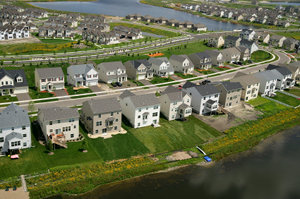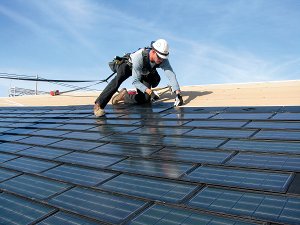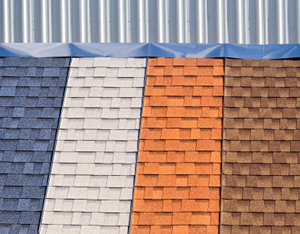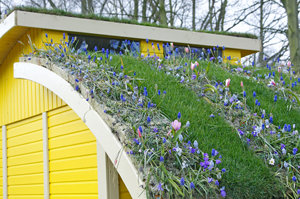Asphalt Shingles Get Greener

Asphalt shingles have become the most popular residential roofing material in the US through a combined one-two punch of cost-effectiveness and impressive resilience. However, analysts criticize these shingles for several reasons, including that they: absorb too much heat; increase our reliance on petroleum; and fill too many landfills. Worse, by failing to efficiently harness the sunlight that strikes them, traditional asphalt shingles represent a lost opportunity to generate solar electricity.
In response, a number of companies are working to "green" asphalt shingles. This environmental makeover focuses on three innovations: embedding next-generation solar panels in asphalt shingles, creating so-called "cool roofs" which reflect more sunlight, and the better recycling of old shingles. The federal government is backing these innovations with cold, hard tax credits, so if you're thinking about replacing your roof, this article might put an extra $1,500 in your pocket.
The Problem with Asphalt Shingles
At their heart asphalt shingles are a petroleum product -- they are made from the leftover residue after fuels and lubricating oils have been distilled from petroleum -- and as with every product made from petroleum they come with a number of environmental challenges. Not the least of which, they are energy intensive to produce and petroleum simply is not an environmentally friendly product to extract from the ground or to work with.
They are also incredibly popular with homeowners because they are very easy to install and far less expensive than greener alternatives such as tile, wood, cedar, slate, and metal. They are also fairly good at doing the job they are designed for--protecting your roof from the elements--while lasting on average for 20 or more years.
According to the Asphalt Roofing Manufacturers Association, asphalt shingles are used to cover four out of five homes in the U.S. and more than 12.5 billion square feet of asphalt shingle products are manufactured each year.
With their popularity come two important environmental impacts: Not only is this petroleum product being produced on a massive scale, but the waist created when these roofs are torn off and replaced is also on a massive scale. According to the U.S. Environmental Protection Agency (EPA), more than 11 million tons of waste shingles are generated every year making asphalt shingles responsible for about eight percent of the building-related waste stream in the U.S. This huge volume of roofing debris is overburdening landfills while their petroleum content is creating additional issues as it breaks down in landfills.
Despite their environmental impact, the popularity of asphalt shingles means they aren't going to be replaced by a greener alternative any time soon. Therefore, the question then becomes: If asphalt shingles aren't going anywhere, how can we reduce their impact on the planet?
Three Possible Answers
When talking to people with experience in green building products, especially those with expertise in the area of asphalt shingles, it immediately becomes clear that there is no single magic green bullet. However, there are three key elements to help spruce these products up a bit, especially when used synergistically.
Photovoltaic Shingles - Of all the innovations of the last year or so, the one that is by far the most interesting is the marriage of asphalt shingles with photovoltaic cells. Photovoltaic cells are disks or small squares of silicon and copper indium selenide that are capable of turning solar radiation (e.g. sunlight) into direct current electricity. Generally, these cells are arranged in large rectangular sheets-- known as arrays--and attached to the roof to collect sunlight. As such, they are large appendages that stick out like a sore thumb, though for those who have these arrays they are the proud mark of environmentalism.

While effective at generating electricity--especially in sunnier climates--these arrays are expensive and require a certain degree of expertise to install.
By contrast, photovoltaic shingles--commonly known in the industry as Building Integrated Photovoltaic arrays--are individual cells that look just like an asphalt shingle. They are attached to the roof in the same manner as an asphalt shingle to create an array. These shingles are then blended with real asphalt shingles to create the appearance of a normal, shingled roof.
According to Dow Chemical Company--one of a handful of manufacturers of these shingles that includes Oksolar and Atlantis Energy Systems--these shingles are less expensive than traditional solar arrays. In part, this is due to the use of less expensive, but equally functional materials in manufacture, efficiencies gained from mass production, and the fact that installation can be done by nearly any roofing contractor. In all, the company expects its product to be 10 to 15 percent less expensive than a standard rack mounted system.
According to Jane Palmieri, managing director of solar solutions for Dow, these and related products are "a true enabler to make solar power more affordable for the masses." She goes on to add that Dow's product "shaves anywhere from two to seven years from the payback periods compared to competitive rooftop integrated products, making the systems affordable to a much larger population. Dow does expect that costs will continue to drop as manufacturing scale-up is achieved for components and services across the industry."
Perhaps what is most interesting about Dow's entry into this market is what it says about the market's expected growth trend. "The Dow Powerhouse Solar Shingle opens a much larger addressable market than conventional residential rooftop solar market estimates," says Palmieri. "We foresee a potential addressable market of $5 billion by 2015."
Additionally, Palmieris says the drivers behind market trend are
- improvements in affordability
- the ability to integrate with asphalt shingles, which are the most prevalent roofing material in the U.S.
- the neighborhood friendly aesthetics achieved by the shingles
- increasing solar incentives and renewable energy portfolio standards offered nationally
Cool roof technology is just as it sounds--using color and other elements to improve the heat characteristics of a roof.

For example, says Hashem Akbari, professor of Industrial Research at Concordia University, simply using a lighter colored shingle will cause more sunlight and heat to be reflected back into the atmosphere thereby reducing the cooling load for the home at a low cost to the homeowner. Additionally, the roof will last longer because one of the factors that lead to roof failure is continual expansion and contracting in the roofing materials--this is especially true for asphalt shingles--as temperatures rise and fall during any 24 hour period. Lighter colors will reduce this contraction by minimizing heat absorption.
Cool color technology, however, is more than just simply changing the color of the asphalt shingles. It is about developing and implementing coatings with inherently more powerful reflective properties. When asphalt shingles are manufactured a fiberglass mat is soaked in asphalt to create the shingle. Mineral granules are then used to cover the surface to protect the asphalt from solar radiation. During production these granules can be coated with relatively inexpensive materials that are highly reflective of solar energy.
According to Sherry Hao, administrative manager for the Cool Roof Rating Council, sunlight is composed of three elements--ultraviolet, visible and near-infrared light. Approximately 50 percent of sunlight is near-infrared light, which is not visible to the human eye, but is absorbed by the roof as heat. Cool roofing technologies are very good at reflecting near-infrared light, which makes it very good at keeping a home or any other building much cooler than it otherwise would be.
By some estimates, this technology can reduce roof temperatures by as much as 100 degrees.
Additionally, because near-infrared light is not visible to the eye, the color of the shingle does not have to change because there is the same heat reflectance with a darker color as with a lighter color, though a homeowner would see more overall benefit from a lighter color. "If the sun's energy is being reflected off the roof," says Hao, "it is not being transmitted to the building below. For homes that are in places that are hot or that have hot summers, these roofs will reduce overall cooling costs for homeowners. On a global scale, it is a climate change mitigation strategy too because cool roof technology sends the sun's warming energy back into the atmosphere rather than adding to the warming of the globe."
As a side note, when considering the slope of most residential roofs, a white roof will likely create a rather intense glare making homeowners with these roofs rather unpopular with their neighbors. Being able to use darker colored shingles while increasing heat reflectance solves this problem.
In terms of savings, Akbari says homeowners could save 10 cents per square foot of roof per year in cooling and offset as much as one ton of CO2 per 10 square meters of roof. Other sources used for this story estimate that cooling bills could be reduced by as much as 10 to 15 percent.
Akbari goes on to add that these savings can increase dramatically if cool roof shingles are integrated with the photovoltaic shingles discussed above, though he does note that the cost of photovoltaic shingles is quite a bit more than cool roof shingles. "It is important to use both of these shingles to maximize your ability to create the efficiency to save money as well as reduce overall greenhouse emissions," he says.
While this technology helps on the cooling side, what about homeowners living in areas where heating is a concern? The fact is, if you live in an area with a cool climate the savings you will receive from cool roof technology will be reduced during winter months. However, the amount of heat gain from a non- reflective roof during winter is far less than one would think due to attic insulation that resists both cold and warmth from penetrating the roof and the reflective properties of snow when it collects on a roof.
Therefore, according to Akbari and others, even people living in northern climates will receive a net benefit from cool roof technology. "This is a very surprising issue," he says. "Any building anywhere in the world, by installing a cool roof will on net save energy because even in places with cold seasons the days are shorter, the sun angle is lower and clouds are more prevalent, so roofs are not absorbing as much energy. When you put all of this together, you find that any negative effect of cool roof technology is minimal."
Asked where the market is heading for these products, Akbari said that it is growing as more states embrace this technology. For example, California is requiring new state buildings and renovations include cool roof technologies. "The market is still growing and there are more and more leading manufacturers coming out with products," he adds.
Adding to the demand for cool roof products are tax benefits that can be garnered by homeowners and businesses. According to Energy Star, asphalt shingles employing cool roof technology must meet certain requirements in order to qualify for the federal tax credit, which can be worth as much as $1,500 for 2009 and 2010. Hao adds that state governments and local utilities are offering rebate programs in order to support adoption of cool roof materials.

Improve Recycling - For many homeowners, cool roof and photovoltaic technologies may not be affordable or realistic alternatives for them to pursue. Additionally, there are already an immense number of asphalt shingles currently in use. For this reason the EPA as well as a handful of other entities such as the Northeast Recycling Council, are working to improve recycling
According to Julie Gevrenov, an environmental engineer with the EPA, asphalt shingles contain asphalt binder, mineral aggregate as well as other materials that make them a perfect choice for certain paving needs. In particular, she says, recycled shingles work well in hot-mix asphalt. "There are a number of state departments of transportation that have developed specifications related to the use of recycled shingles, such as the size of the material, how much of it can be used, and level of contaminates that can be in it, so it meets their very high quality requirements as a paving material.
According to ShingleRecycling.org, a website created by the Construction Materials Recycling Association, recycled shingles can reduce the overall cost of paving because it is far less expensive than virgin asphalt and aggregate. The website also says that recycled shingles can be used for:
- Cold patch
- Dust control on rural roads
- For temporary roads and driveways
- Aggregate road base
- And even to manufacture new shingles
Despite the promise of recycled shingles, there are a couple of challenges that must first be overcome, says Gevrenov.
The first is that it is not a well developed market. "It is one thing to say we can make a product, but there has to be a market within which that material can go," she says. Critical to enabling a market to develop is the establishment by state highway departments of a set of specifications for how recycled shingles should be used in state and local paving projects.
Additionally, says Gevrenov, there needs to be an infrastructure developed to support the market. "The infrastructure for taking shingles from a roof, transporting them, recycling them into a usable material and then to a paving job is not well developed," she says. "It will take some work to develop this infrastructure."
However, the benefits of recycled shingles in terms of cost savings and reduced impact to landfills is driving development of a market and supporting infrastructure. Another important driver has been increases in the cost of asphalt over the past few years due to higher petroleum and aggregate costs is causing paving companies to seek out less expensive alternatives.
The last hurdle is one of perception versus reality, says Gevrenov. In the past, asphalt shingled roofs used asbestos in the matting that underlies the shingles. There is some risk that older roofs may still have this asbestos. "People are sensitive to asbestos and basically everything I hear is that in the agencies that are testing for it there is a very low hit rate for asbestos," says Gevrenov. "But there is still the potential that somebody could come across a contaminated load. I don't think this is so much a barrier, but it is concern."
Additional Innovations
Photovoltaic shingles, cool roof technologies and recycling older waste shingles when used synergistically can go a long way toward reducing the environmental impact of asphalt shingles. However, there are a couple of other products and innovations being developed that are worth mentioning.
In terms of the photovoltaic shingles, Palmieri of Dow says that photovoltaic manufacturers are continually striving to create more powerful products. "Although [the material we use] is the highest efficiency thin film photovoltaic material available, it has the potential--demonstrated in the lab-- to improve even further in both performance and cost," she says. "Manufacturers are continually improving its light capture performance and cost, and we expect these improvements to continue over the next three to five years."
The same can be said for cool roof technologies. Akbari says manufacturers are working to make their products more reflective, longer lasting and generally cooler. Hao adds there is glass microsphere technology being developed where very tiny glass crystals are added to the reflective coating to increase reflectance.
There is also a new technology being developed by a team of graduate students at MIT, says Hao, which is a thermo chromatic tile. The tile turns white as the outside temperature increases and back to black as the temperature decreases. According to news reports, these tiles could be massed produced at a cost that is less than traditional asphalt tiles.
When all of these innovations are taken together, the ability to use a combination of strategies to mitigate the environmental impact of asphalt shingles is very real. Even though asphalt shingles are at heart a petroleum product, the greening trend is undeniable in terms of availability, innovation, effectiveness and cost.

